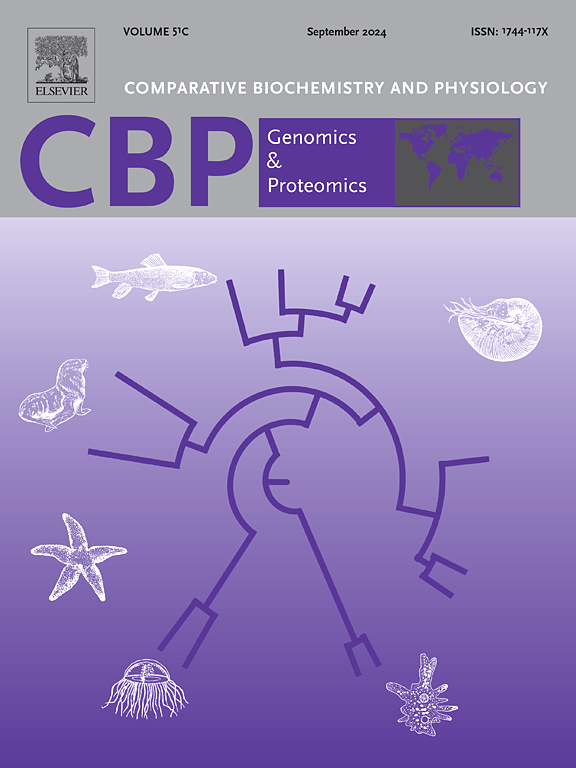比较转录组分析鉴定了红鳍东方鲀卵巢发育相关基因。
IF 2.2
2区 生物学
Q4 BIOCHEMISTRY & MOLECULAR BIOLOGY
Comparative Biochemistry and Physiology D-Genomics & Proteomics
Pub Date : 2024-12-22
DOI:10.1016/j.cbd.2024.101407
引用次数: 0
摘要
卵巢发育是一个涉及多个基因的复杂过程,但在红鳍东方鲀中这一过程的分子机制尚不清楚。本研究旨在鉴定红带绦虫卵巢发育相关基因,探讨卵母细胞成熟的调控机制。研究人员比较了四个不同发育阶段(II期至V期)的转录组数据,以鉴定差异表达基因(DEGs),并进行GO和KEGG富集分析。然后用qPCR验证随机选择的基因的表达模式。结果从所有文库中获得了1,289,401,820个原始数据,在所有比较组中确定了16,929个deg。deg主要富集于卵巢类固醇生成、雌激素介导的信号通路和tgf - β信号通路。qPCR分析显示,cyp17a1在II期和III期的表达水平相似。随后,cyp17a1在III期至v期持续表达增加,cyp19a1、nanos1、foxl2和ar在II期和III期表达水平相似,然后从III期至IV期表达增加,随后从IV期至v期表达下调。hsd17b1在II期和IV期表达水平相似。本研究代表了雌性红斑t细胞卵巢发育的转录组学研究。几个重要的卵巢相关基因和性别相关的生物学途径被确定。该结果将提高我们对该物种卵巢发育的分子机制的理解。本文章由计算机程序翻译,如有差异,请以英文原文为准。

Comparative transcriptome analysis identified genes involved in ovarian development in Takifugu rubripes
Ovarian development is a complex process involving multiple genes, but the molecular mechanisms underlying this process in Takifugu rubripes remain poorly understood. This study aimed to identify genes associated with ovarian development in T. rubripes and to investigate the regulatory mechanisms of oocyte maturation. Transcriptome data were compared across four different developmental stages (stage II to V) to identify differentially expressed genes (DEGs) and perform GO and KEGG enrichment analysis. The expression patterns of randomly selected genes were then validated by qPCR. The results yielded a total of 1,289,401,820 raw data from all libraries, with 16,929 DEGs identified across all comparison groups. The DEGs were predominantly enriched in ovarian steroidogenesis, estrogen-mediated signaling, and TGF-beta signaling pathways. The qPCR analysis showed that cyp17a1 was identified as being expressed at similar levels in stage II and III. Thereafter, cyp17a1 was observed to undergo a continuous increase in expression from stage III to V. cyp19a1, nanos1, foxl2 and ar were identified as being expressed at similar levels at stage II and III, then increase in expression from stage III to IV and subsequent downregulation from stage IV to V. hsd17b1 was identified as being expressed at similar levels at stage II and IV. This study represents a transcriptomic study of ovarian development in female T. rubripes. Several essential ovarian-related genes and sex-related biological pathways were identified. The results will improve our understanding of the molecular mechanisms underlying ovarian development in this species.
求助全文
通过发布文献求助,成功后即可免费获取论文全文。
去求助
来源期刊
CiteScore
5.10
自引率
3.30%
发文量
69
审稿时长
33 days
期刊介绍:
Comparative Biochemistry & Physiology (CBP) publishes papers in comparative, environmental and evolutionary physiology.
Part D: Genomics and Proteomics (CBPD), focuses on “omics” approaches to physiology, including comparative and functional genomics, metagenomics, transcriptomics, proteomics, metabolomics, and lipidomics. Most studies employ “omics” and/or system biology to test specific hypotheses about molecular and biochemical mechanisms underlying physiological responses to the environment. We encourage papers that address fundamental questions in comparative physiology and biochemistry rather than studies with a focus that is purely technical, methodological or descriptive in nature.

 求助内容:
求助内容: 应助结果提醒方式:
应助结果提醒方式:


